Relationship Between Recurrent Magnetic Flux Rope and Moving Magnetic Features
Abstract
1. Introduction
2. Data and Observations
3. Analyses and Observational Results
3.1. Long Term Evolution of Active Regions
3.2. Recurrence of the MFR
3.2.1. Overview of the Recurrence of the MFR
3.2.2. Jul 18 05:42–06:31
3.3. Magnetic Configuration
3.3.1. Large-Scale Magnetic Connection
3.3.2. Magnetic Moving Feature Around the Initial Brightening Area
4. Conclusions
Author Contributions
Funding
Data Availability Statement
Acknowledgments
Conflicts of Interest
Abbreviations
| MFR | Magnetic flux rope; |
| MMF | Moving magnetic feature; |
| CME | Coronal mass ejection; |
| PIL | Polarity inversion line; |
| FMG | Full-disk magnetogram; |
| ASO-S | Advanced Space-Based Solar Observatory; |
| UV | Ultraviolet; |
| EUV | Extreme ultraviolet; |
| SDO | Solar Dynamic Observatory; |
| AIA | Atmospheric Imaging Assembly; |
| HMI | Helioseismic and Magnetic Imager; |
| SMAT | Solar Magnetism and Activity Telescope; |
| GOES | Geostationary Operational Environmental Satellites. |
References
- Chase, L.F.; Jordan, W.C.; Perez, J.D.; Johnston, R.R. X-ray Spectrum of a Laser-produced Iron Plasma. Phys. Rev. A 1976, 13, 1497. [Google Scholar] [CrossRef]
- Stewart, R.T.; Vorpahl, J. Radio and soft X-ray evidence for dense non-potential magnetic flux tubes in the solar system. Sol. Phys. 1977, 55, 111. [Google Scholar] [CrossRef]
- Tsuneta, S. Structure and Dynamics of Magnetic Reconnection in a Solar Flare. Astrophys. J. 1996, 456, 840. [Google Scholar] [CrossRef]
- Bagalá, L.G.; Mandrini, C.H.; Rovira, M.G.; Démoulin, P. Magnetic reconnection: A common origin for flares and AR interconnecting arcs. Astron. Astrophys. 2000, 363, 779. [Google Scholar]
- Wang, H.; Chae, J.; Yurchyshyn, V.; Yang, G.; Steinegger, M.; Goode, P. Inter-Active Region Connection of Sympathetic Flaring on 2000 February 17. Astrophys. J. 2001, 559, 1171. [Google Scholar] [CrossRef]
- Guité, L.-S.; Strugarek, A.; Charbonneau, P. Flaring together: A preferred angular separation between sympathetic flares on the Sun. Astron. Astrophys. 2025, 694, A74. [Google Scholar] [CrossRef]
- Zhang, Q. Circular-ribbon flares and the related activities. Rev. Mod. Plasma Phys. 2024, 8, 7. [Google Scholar] [CrossRef]
- Jiang, Y.; Yang, J.; Hong, J.; Bi, Y.; Zheng, R. Sympathetic Filament Eruptions Connected by Coronal Dimmings. Astrophys. J. 2011, 738, 179. [Google Scholar] [CrossRef]
- Khan, J.I.; Hudson, H.S. Homologous sudden disappearances of transequatorial interconnecting loops in the solar corona. Geophys. Res. Lett. 2000, 27, 1083. [Google Scholar] [CrossRef]
- Yang, S.B.; Büchner, J.; Zhang, H.Q. Magnetic Helicity Exchange Between Neighboring Active Regions. Astrophys. J. 2009, 695, L25. [Google Scholar] [CrossRef]
- Zhou, G.P.; Wang, J.X.; Wang, Y.M.; Zhang, Y.Z. Quasi-Simultaneous Flux Emergence in the Events of October & November 2003. Sol. Phys. 2007, 244, 13. [Google Scholar]
- Zhou, G.P.; Tan, C.M.; Su, Y.N.; Shen, C.L.; Tan, B.L.; Jin, C.L.; Wang, J.X. Multiple Magnetic Reconnections Driven by a Large-scale Magnetic Flux Rope. Astrophys. J. 2019, 873, 23. [Google Scholar] [CrossRef]
- Zhou, G.P.; Wang, J.X.; Zhang, J. Large-scale source regions of earth-directed coronal mass ejections. Astron. Astrophys. 2006, 445, 1133. [Google Scholar] [CrossRef]
- Sheeley, N.R. The Evolution of the Photoshperic Network. Sol. Phys. 1969, 9, 347. [Google Scholar] [CrossRef]
- Pariat, E.; Antiochos, S.K.; DeVore, C.R. Three-dimensional Modeling of Quasi-homologous Solar Jets. Astrophys. J. 2010, 714, 1762. [Google Scholar] [CrossRef]
- Yang, L.; He, J.; Peter, H.; Tu, C.; Zhang, L.; Feng, X.; Zhang, S. Numerical Simulations of Chromospheric Anemone Jets Associated with Moving Magnetic Features. Astrophys. J. 2013, 777, 16. [Google Scholar] [CrossRef]
- Mou, C.; Huang, Z.; Xia, L.; Madjarska, M.S.; Li, B.; Fu, H.; Jiao, F.; Hou, Z. Magnetic Flux Supplement to Coronal Bright Points. Astrophys. J. 2016, 818, 9. [Google Scholar] [CrossRef]
- Wyper, P.F.; DeVore, C.R. Simulations of Solar Jets Confined by Coronal Loops. Astrophys. J. 2016, 820, 777. [Google Scholar] [CrossRef]
- Wei, H.; Huang, Z.; Li, C.; Hou, Z.; Qiu, Y.; Fu, H.; Bai, X.; Xia, L. Internal Activities in a Solar Filament and Heating in Its Threads. Astrophys. J. 2023, 958, 116. [Google Scholar] [CrossRef]
- Chen, J.; Su, J.; Yin, Z.; Priya, T.G.; Zhang, H.; Liu, J.; Xu, H.; Yu, S. Recurrent Solar Jets Induced by a Satellite Spot and Moving Magnetic Features. Astrophys. J. 2015, 815, 71. [Google Scholar] [CrossRef]
- Zhang, J.; Wang, J. Are Homologous Flare-Coronal Mass Ejection Events Triggered by Moving Magnetic Features? Astrophys. J. 2002, 566, L117. [Google Scholar] [CrossRef]
- Deng, Y.-Y.; Zhang, H.-Y.; Yang, J.-F.; Li, F.; Lin, J.-B.; Hou, J.-F.; Wu, Z.; Song, Q.; Duan, W.; Bai, X.-Y.; et al. Design of the Full-disk MagnetoGraph (FMG) onboard the ASO-S. Res. Astron. Astrophys. 2019, 19, 157. [Google Scholar] [CrossRef]
- Gan, W.; Zhu, C.; Deng, Y.; Zhang, Z.; Chen, B.; Huang, Y.; Deng, L.; Wu, H.; Zhang, H.; Li, H.; et al. The Advanced Space-Based Solar Observatory (ASO-S). Sol. Phys. 2023, 298, 68. [Google Scholar] [CrossRef]
- Pesnell, W.D.; Thompson, B.J.; Chamberlin, P.C. The Solar Dynamics Observatory (SDO); Springer: Greer, SC, USA, 2012; Volume 275, p. 3. [Google Scholar]
- Lemen, J.R.; Title, A.M.; Akin, D.J.; Boerner, P.F.; Chou, C.; Drake, J.F.; Duncan, D.W.; Edwards, C.G.; Friedlaender, F.M.; Heyman, G.F.; et al. The Atmospheric Imaging Assembly (AIA) on the Solar Dynamics Observatory (SDO). Sol. Phys. 2012, 275, 17. [Google Scholar] [CrossRef]
- Schou, J.; Scherrer, P.H.; Bush, R.I.; Wachter, R.; Couvidat, S.; Rabello-Soares, M.C.; Bogart, R.S.; Hoeksema, J.T.; Liu, Y.; Duvall, T.L., Jr.; et al. Design and Ground Calibration of the Helioseismic and Magnetic Imager (HMI) Instrument on the Solar Dynamics Observatory (SDO). Sol. Phys. 2012, 275, 229. [Google Scholar] [CrossRef]
- Zhang, H.-Q.; Wang, D.-G.; Deng, Y.-Y.; Hu, K.-L.; Su, J.-T.; Lin, J.-B.; Lin, G.-H.; Yang, S.-M.; Mao, W.-J.; Wang, Y.-N.; et al. Solar Magnetism and the Activity Telescope at HSOS. Chin. J. Astron. Astrophys. 2007, 7, 281. [Google Scholar] [CrossRef]
- Cheng, X.; Ding, M.D. The characteristics of the footpoints of solar magnetic flux ropes during eruptions. Astrophys. J. Suppl. Ser. 2016, 225, 16. [Google Scholar] [CrossRef]
- Sun, X.; Hoeksema, J.T.; Liu, Y.; Wiegelmann, T.; Hayashi, K.; Chen, Q.; Thalmann, J. Evolution of Magnetic Field and Energy in a Major Eruptive Active Region Based on SDO/HMI Observation. Astrophys. J. 2012, 748, 77. [Google Scholar] [CrossRef]
- Cheng, X.; Ding, M.D.; Zhang, J.; Sun, X.D.; Guo, Y.; Wang, Y.M.; Kliem, B.; Deng, Y.Y. Formation of a Double-decker Magnetic Flux Rope in the Sigmoidal Solar Active Region 11520. Astrophys. J. 2014, 789, 93. [Google Scholar] [CrossRef]
- Vemareddy, P.; Zhang, J. Initiation and Eruption Process of Magnetic Flux Rope from Solar Active Region NOAA 11719 to Earth-directed CME. Astrophys. J. 2014, 797, 80. [Google Scholar] [CrossRef]
- Song, Y.; Su, J.; Zhang, Q.; Zhang, M.; Deng, Y.; Bai, X.; Liu, S.; Yang, X.; Chen, J.; Xu, H.; et al. Observation of a Large-Scale Filament Eruption Initiated by Two Small-Scale Erupting Filaments Pushing Out from Below. Sol. Phy. 2024, 299, 85. [Google Scholar] [CrossRef]
- Schrijver, C.J. Simulations of the Photospheric Magnetic Activity and Outer Atmospheric Radiative Losses of Cool Stars Based on Characteristics of the Solar Magnetic Field. Astrophys. J. 2001, 547, 475. [Google Scholar] [CrossRef]
- Schrijver, C.J.; De Rosa, M.L. Photospheric and heliospheric magnetic fields. Sol. Phys. 2003, 212, 165. [Google Scholar] [CrossRef]
- Tian, H.; Chen, N.-H. Multi-episode Chromospheric Evaporation Observed in a Solar Flare. Astrophys. J. 2018, 856, 34. [Google Scholar] [CrossRef]
- Zhang, Y.; Zhang, M.; Zhang, H. On the Relationship between Flux Emergence and CME Initiation. Sol. Phys. 2008, 250, 75. [Google Scholar] [CrossRef]
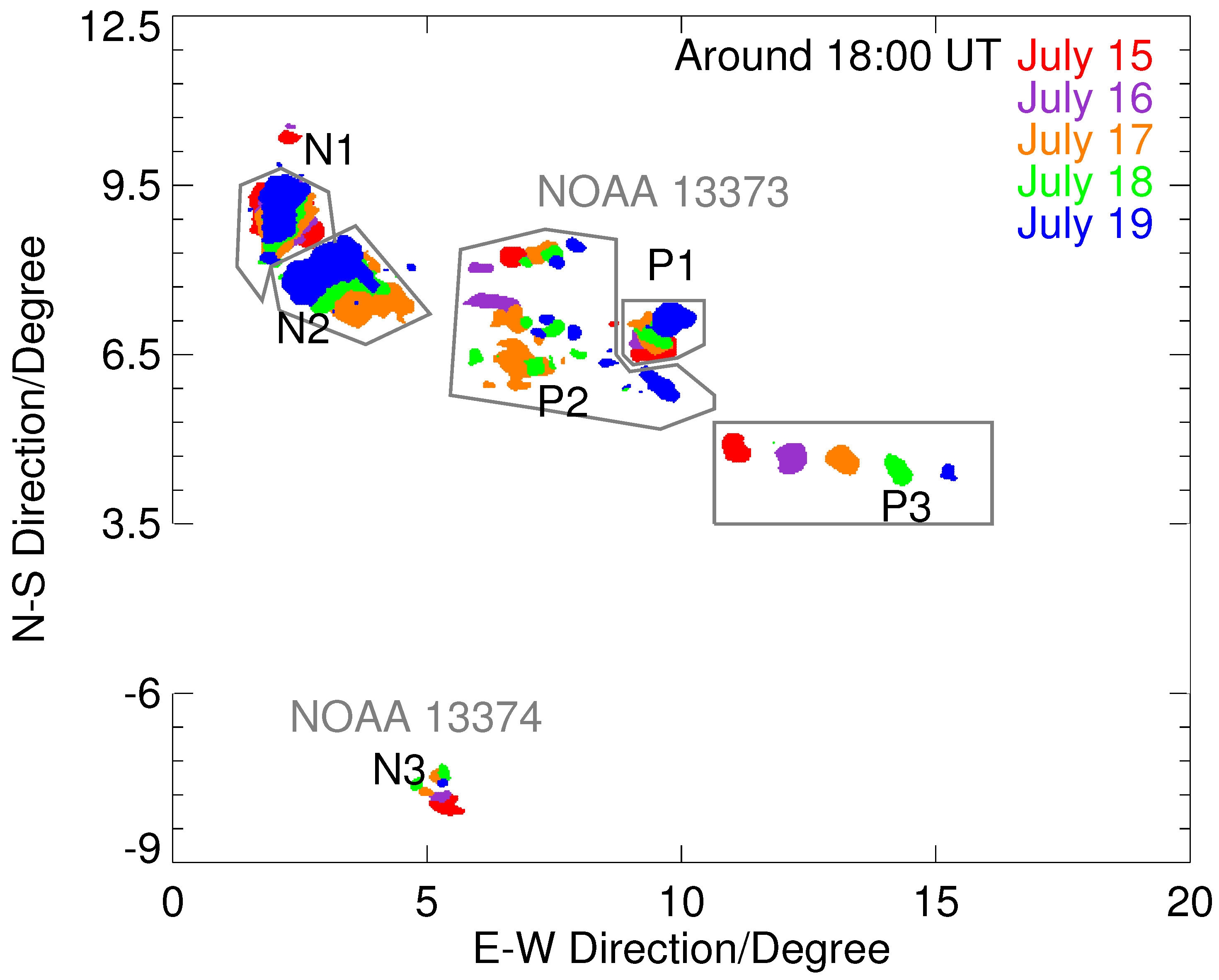
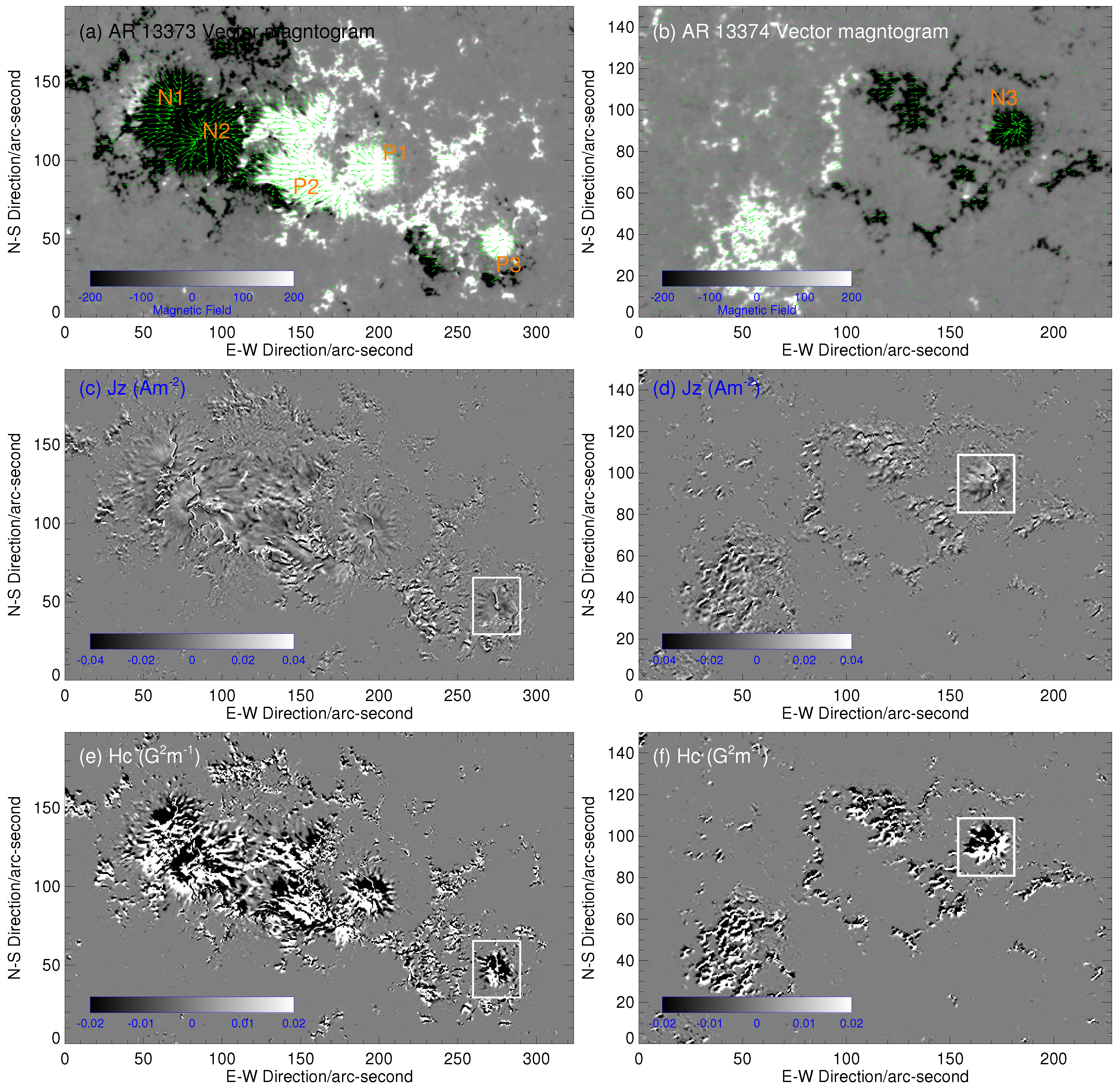

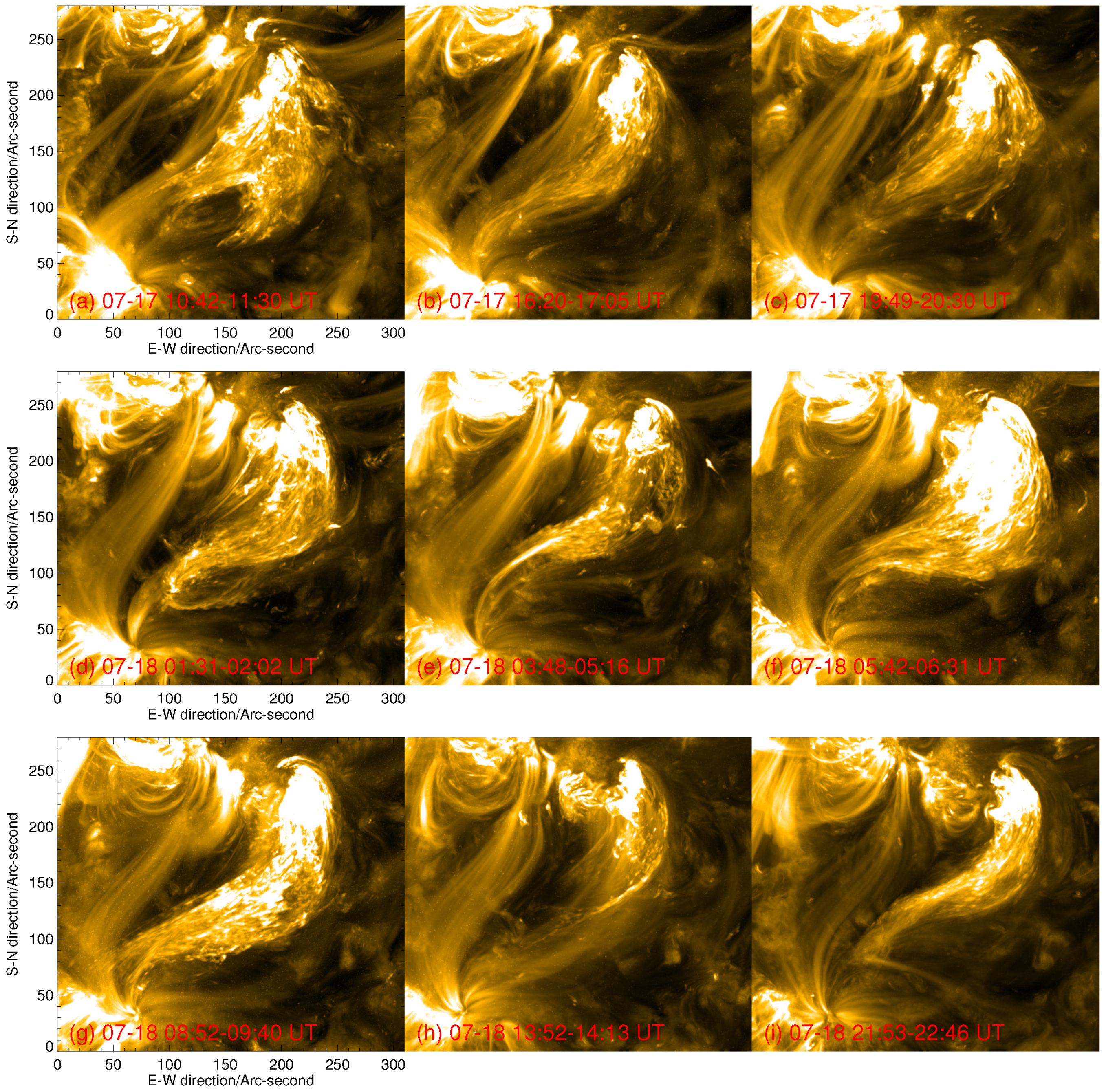
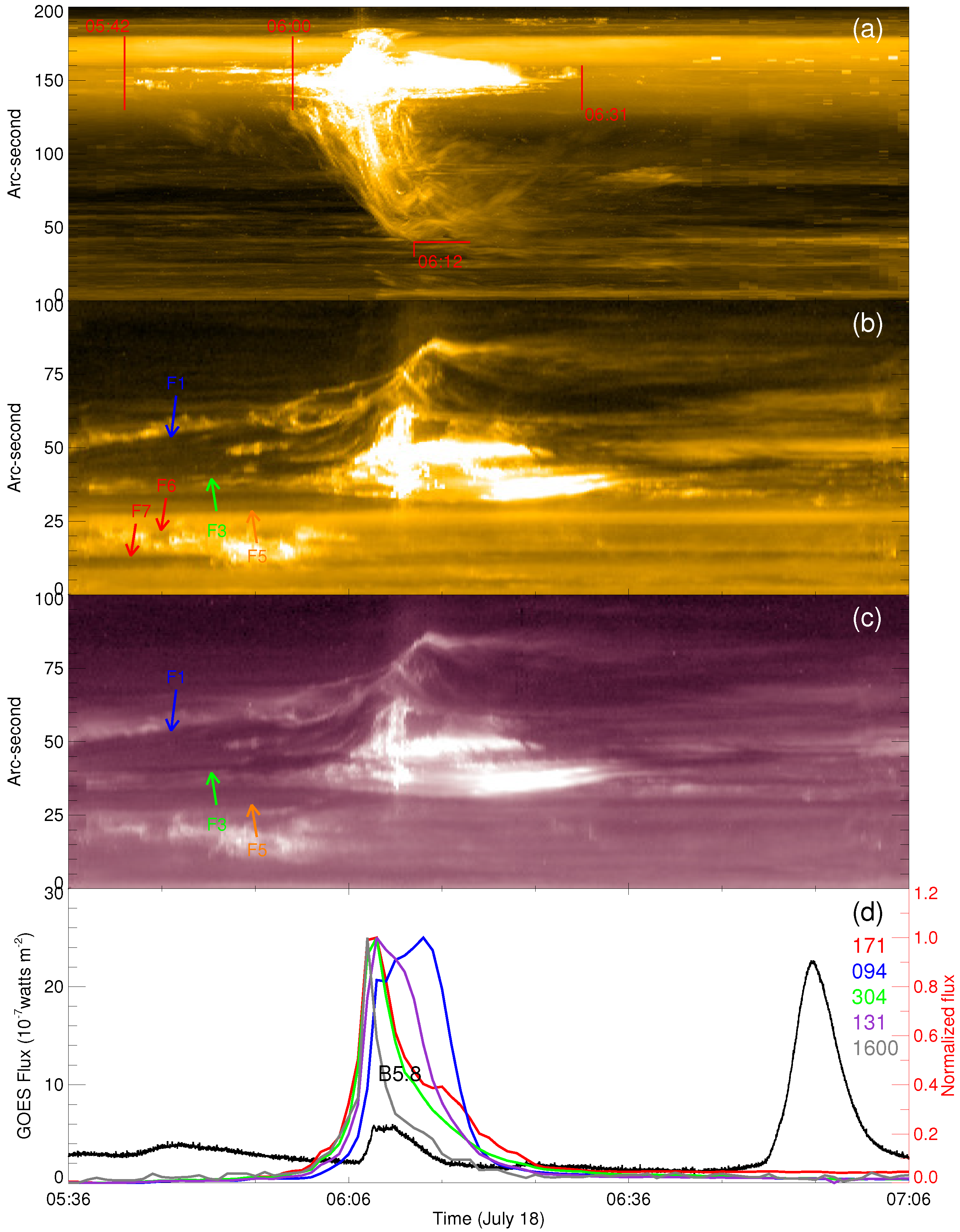
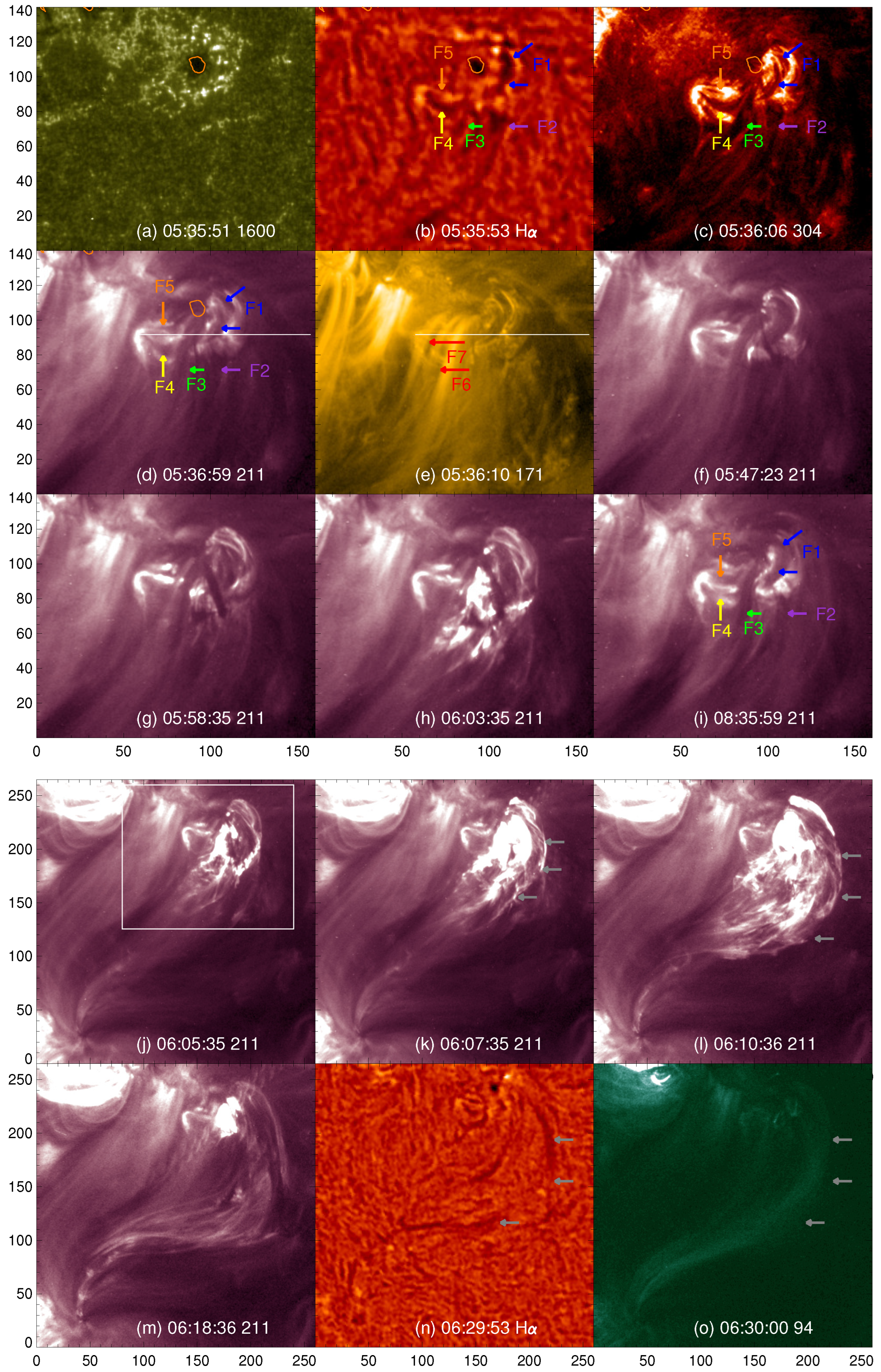
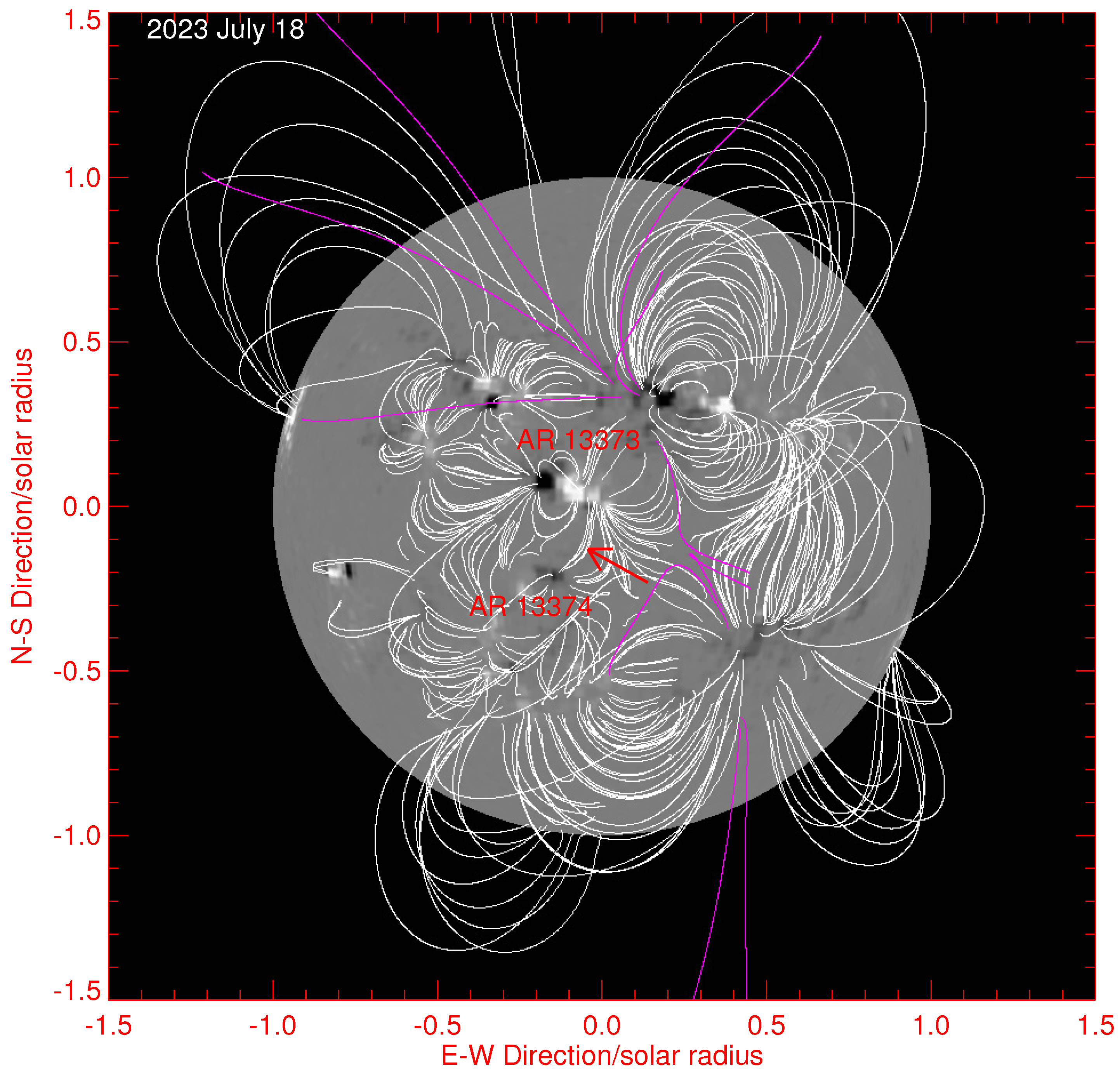
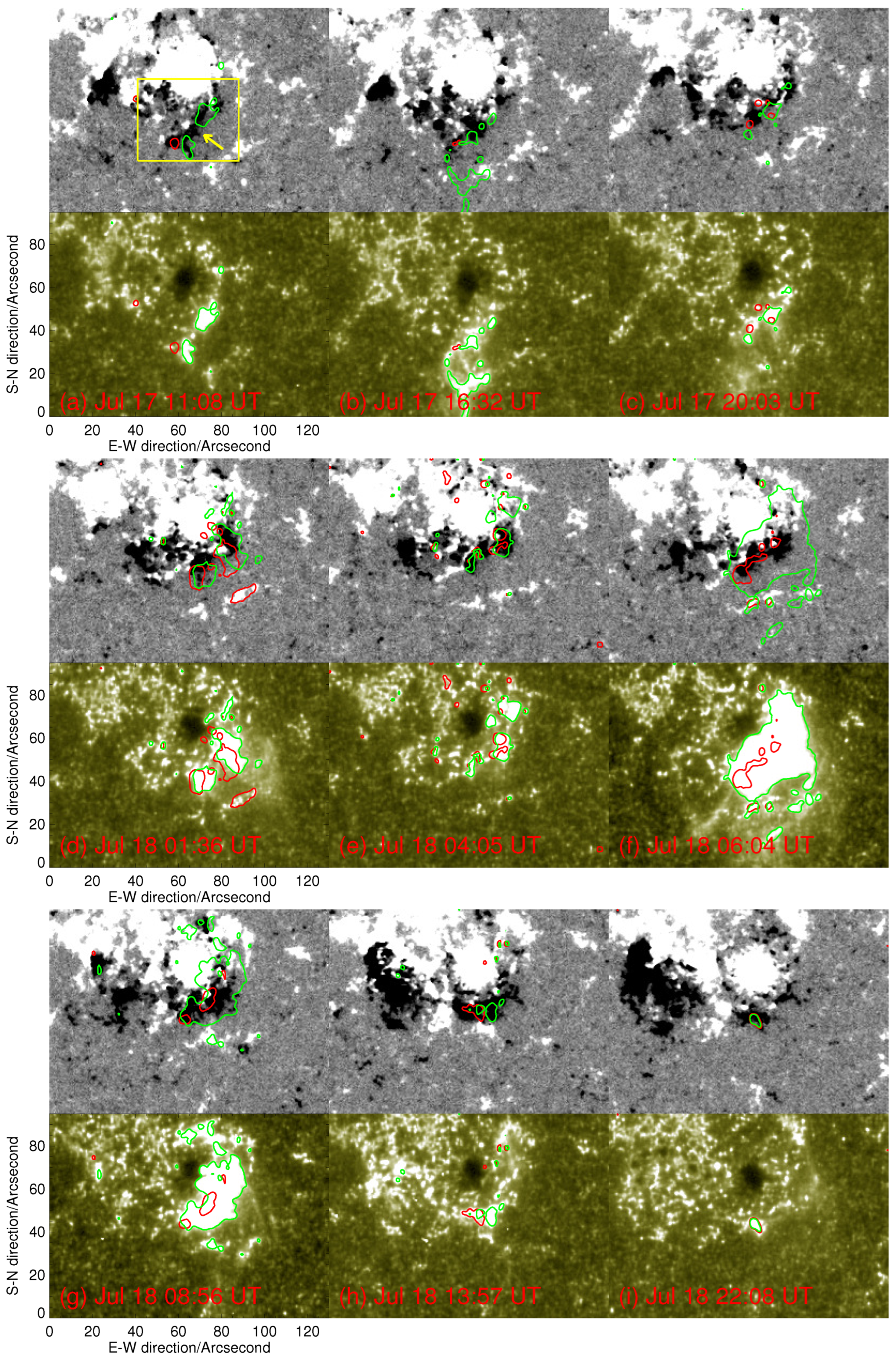
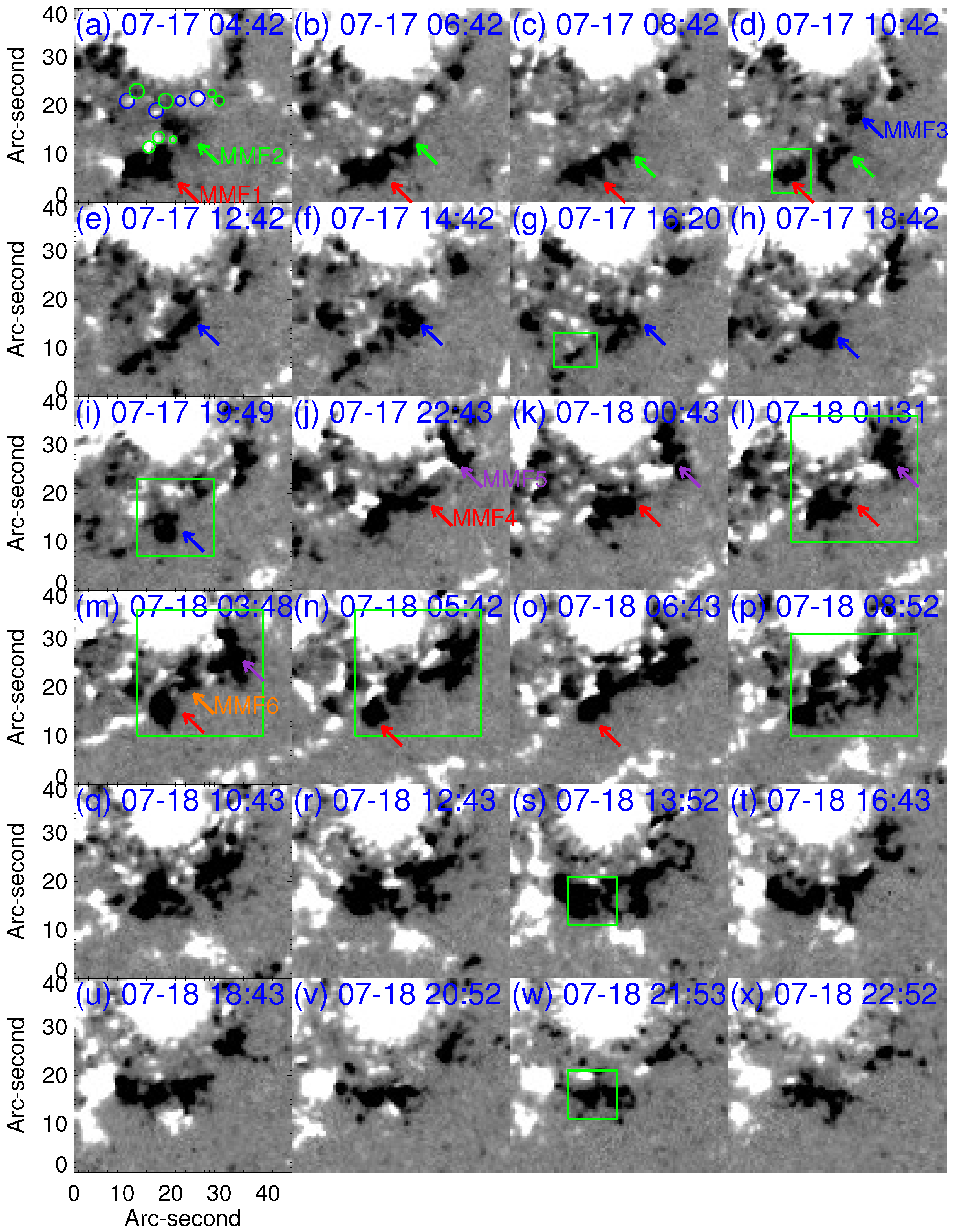
| Num | Date | Tstart | Tpeak | Tend | GOES 1 | DN 2 | MMF 3 |
|---|---|---|---|---|---|---|---|
| 01 | 07-17 | 10:42 | 11:09 | 11:30 | No | 2.4 | N |
| 02 | 07-17 | 16:20 | 16:32 | 17:05 | No | 3.4 | N |
| 03 | 07-17 | 19:49 | 20:03 | 20:30 | No | 2.9 | P&N |
| 04 | 07-18 | 01:31 | 01:37 | 02:02 | No | 6.0 | P&N |
| 05 | 07-18 | 03:48 | 04:05 | 05:16 | No | 1.7 | P&N |
| 06 | 07-18 | 05:42 | 06:08 | 06:31 | B5.8 | 31.0 | P&N |
| 07 | 07-18 | 08:52 | 09:04 | 09:40 | C4.4 | 12.8 | P&N |
| 08 | 07-18 | 13:52 | 13:59 | 14:13 | No | 1.6 | N |
| 09 | 07-18 | 21:53 | 22:08 | 22:46 | No | 0.6 | N |
Disclaimer/Publisher’s Note: The statements, opinions and data contained in all publications are solely those of the individual author(s) and contributor(s) and not of MDPI and/or the editor(s). MDPI and/or the editor(s) disclaim responsibility for any injury to people or property resulting from any ideas, methods, instructions or products referred to in the content. |
© 2025 by the authors. Licensee MDPI, Basel, Switzerland. This article is an open access article distributed under the terms and conditions of the Creative Commons Attribution (CC BY) license (https://creativecommons.org/licenses/by/4.0/).
Share and Cite
Zhang, Y.; Liu, J.; Wang, Q.; Liu, S.; Huang, J.; Chen, J.; Tan, B. Relationship Between Recurrent Magnetic Flux Rope and Moving Magnetic Features. Universe 2025, 11, 222. https://doi.org/10.3390/universe11070222
Zhang Y, Liu J, Wang Q, Liu S, Huang J, Chen J, Tan B. Relationship Between Recurrent Magnetic Flux Rope and Moving Magnetic Features. Universe. 2025; 11(7):222. https://doi.org/10.3390/universe11070222
Chicago/Turabian StyleZhang, Yin, Jihong Liu, Quan Wang, Suo Liu, Jing Huang, Jie Chen, and Baolin Tan. 2025. "Relationship Between Recurrent Magnetic Flux Rope and Moving Magnetic Features" Universe 11, no. 7: 222. https://doi.org/10.3390/universe11070222
APA StyleZhang, Y., Liu, J., Wang, Q., Liu, S., Huang, J., Chen, J., & Tan, B. (2025). Relationship Between Recurrent Magnetic Flux Rope and Moving Magnetic Features. Universe, 11(7), 222. https://doi.org/10.3390/universe11070222







